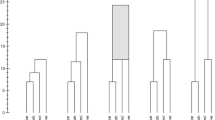Abstract
Topological techniques provide robust tools for data analysis. They are used, for example, for feature extraction, for data de-noising, and for comparison of data sets. This chapter concerns contour trees, a topological descriptor that records the connectivity of the isosurfaces of scalar functions. These trees are fundamental to analysis and visualization of physical phenomena modeled by real-valued measurements.
We study the parallel analysis of contour trees. After describing a particular representation of a contour tree, called local–global representation, we illustrate how different problems that rely on contour trees can be solved in parallel with minimal communication.
Access this chapter
Tax calculation will be finalised at checkout
Purchases are for personal use only
Similar content being viewed by others
Notes
- 1.
The algorithm of [7] is an exception. It computes many descriptors, Morse–Smale complexes of smaller portions of the domain. However, this information is not sufficient to resolve the Morse–Smale complex of the entire function. In particular, [7] ignores how one would use such a representation for the actual analysis. In our terminology, these descriptors are the local representations.
- 2.
Sometimes authors make distinction between merge trees of super- and sub-level sets, calling the former join and the latter split trees. We prefer a unified terminology in this chapter.
References
L. Arge, M. Revsbaek, I/O-efficient contour tree simplification, in Proceedings of the International Symposium on Algorithms and Computation, Honolulu. LNCS 5878 (Springer, Berlin/Heidelberg, 2009), pp. 1155–1165
H. Carr, J. Snoeyink, U. Axen, Computing contour trees in all dimensions. Comput. Geom. Theory Appl. 24(2), 75–94 (2003)
H. Carr, J. Snoeyink, M. van de Panne, Flexible isosurfaces: simplifying and displaying scalar topology using the contour tree. Comput. Geom. Theory Appl. 43(1), 42–58 (2010)
Y.-J. Chiang, X. Lu, Progressive simplification of tetrahedral meshes preserving all isosurface topologies. Comput. Graph. Forum 22(3), 493–504 (2003)
H. Childs, E. Brugger, B. Whitlock, J. Meredith, S. Ahern, D. Pugmire, K. Biagas, M. Miller, C. Harrison, G.H. Weber, H. Krishnan, T. Fogal, A. Sanderson, C. Garth, E.W. Bethel, D. Camp, O. Rübel, M. Durant, J.M. Favre, P. Navrátil, VisIt: an end-user tool for visualizing and analyzing very large data, in High Performance Visualization—Enabling Extreme-Scale Scientific Insight (CRC, Hoboken, 2012), pp. 357–372
H. Edelsbrunner, J. Harer, Persistent Homology—A survey. Volume 453 of Contemporary Mathematics (AMS, Providence, 2008), pp. 257–282
A. Gyulassy, V. Pascucci, T. Peterka, R. Ross, The parallel computation of Morse–Smale complexes, in IEEE IPDPS, Shanghai, 2012, pp. 484–495
C. Harrison, H. Childs, K.P. Gaither, Data-parallel mesh connected components labeling and analysis, in Proceedings of the 11th EG PGV, Switzerland, 2011, pp. 131–140
M. Hilaga, Y. Shinagawa, T. Kohmura, T.L. Kunii, Topology matching for fully automatic similarity estimation of 3D shapes, in Proceedings of the 28th Annual Conference on Computer Graphics and Interactive Techniques, SIGGRAPH ’01, Los Angeles, 2001, pp. 203–212
W. E. Lorensen, H.E. Cline, Marching cubes: a high resolution 3D surface construction algorithm. Comput. Graph. 21(4), 163–169 (1987)
K.-L. Ma, J.S. Painter, C.D. Hansen, M.F. Krogh, Parallel volume rendering using binary-swap compositing. IEEE Comput. Graph. Appl. 14(4), 59–68 (1994)
S. Molnar, M. Cox, D. Ellsworth, H. Fuchs, A sorting classification of parallel rendering. IEEE Comput. Graph. Appl. 14(4), 23–32 (1994)
C. Montani, R. Scateni, R. Scopigno, A modified look-up table for implicit disambiguation of marching cubes. Vis. Comput. 10(6), 353–355 (1994)
D. Morozov, G.H. Weber, Distributed merge trees, in Proceedings of the ACM Symposium Principles and Practice of Parallel Programming, Shenzhen, 2013, pp. 93–102
G. Nielson, On marching cubes. IEEE Trans. Vis. Comput. Graph. 9(3), 341–351 (2003)
V. Pascucci, K. Cole-McLaughlin, Parallel computation of the topology of level sets. Algorithmica 38(1), 249–268 (2003)
T. Peterka, D. Goodell, R. Ross, H.-W. Shen, R. Thakur, A configurable algorithm for parallel image-compositing applications, in Proceedings of the SC, Portland, 2009, pp. 4:1–4:10
G. Reeb, Sur les points singuliers d’une forme de pfaff complètement intégrable ou d’une fonction numérique. CR Acad. Sci. 222, 847–849 (1946)
N. Shivashankar, V. Natarajan, Parallel computation of 3D Morse–Smale complexes. Comput. Graph. Forum 31, 965–974 (2012)
N. Shivashankar, M. Senthilnathan, V. Natarajan, Parallel computation of 2D Morse–Smale complexes. IEEE Trans. Vis. Comput. Graph. 18(10), 1757–1770 (2012)
D.M. Ushizima, D. Morozov, G.H. Weber, A.G. Bianchi, J.A. Sethian, E.W. Bethel, Augmented topological descriptors of pore networks for material science. IEEE Trans. Vis. Comput. Graph. 18(12), 2041–2050 (2012)
M. van Kreveld, R. van Oostrum, C. Bajaj, V. Pascucci, D. Schikore, Contour trees and small seed sets for isosurface traversal, in Proceedings of the Annual Symposium Computational Geometry, New York, 1997, pp. 212–220
G.H. Weber, P.-T. Bremer, M.S. Day, J.B. Bell, V. Pascucci, Feature tracking using reeb graphs, in Topological Methods in Data Analysis and Visualization: Theory, Algorithms, and Applications (Springer, Berlin/Heidelberg, 2011) pp. 241–253
G.H. Weber, S.E. Dillard, H. Carr, V. Pascucci, B. Hamann, Topology-controlled volume rendering. IEEE Trans. Vis. Comput. Graph. 13(2), 330–341 (2007)
Acknowledgements
This work was supported by the Director, Office of Advanced Scientific Computing Research, Office of Science, of the U.S. DOE under Contract No. DE-AC02-05CH11231 (Lawrence Berkeley National Laboratory) through the grant “Topology-based Visualization and Analysis of High-dimensional Data and Time-varying Data at the Extreme Scale,” program manager Lucy Nowell.
Author information
Authors and Affiliations
Corresponding author
Editor information
Editors and Affiliations
Rights and permissions
Copyright information
© 2014 Springer International Publishing Switzerland
About this paper
Cite this paper
Morozov, D., Weber, G.H. (2014). Distributed Contour Trees. In: Bremer, PT., Hotz, I., Pascucci, V., Peikert, R. (eds) Topological Methods in Data Analysis and Visualization III. Mathematics and Visualization. Springer, Cham. https://doi.org/10.1007/978-3-319-04099-8_6
Download citation
DOI: https://doi.org/10.1007/978-3-319-04099-8_6
Published:
Publisher Name: Springer, Cham
Print ISBN: 978-3-319-04098-1
Online ISBN: 978-3-319-04099-8
eBook Packages: Mathematics and StatisticsMathematics and Statistics (R0)




